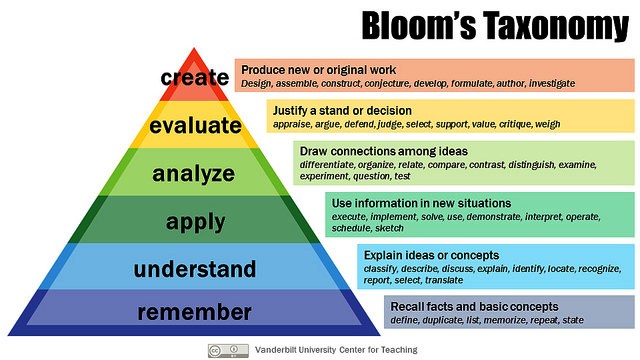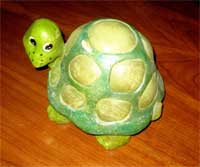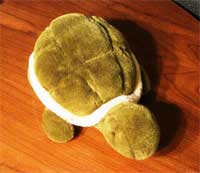Bloom’s Taxonomy Hierarchy of Levels of Thinking
- Knowledge: remembering facts and ideas
- Comprehension: understanding information
- Application: applying facts in new way
- Analysis: making inferences about ideas
- Synthesis: putting facts in new pattern
- Evaluation: making judgments about ideas
|
As a reader, you often mostly learn information. However, inquiry-based learning encourages more engagement in what you read. The inquiry-based strategy of thinking like the author of a story or book immerses a reader in the content. Then the reader can design critical and creative questions about an author’s writing process, purpose, clarity of ideas and language, and text structure.
Inquiry-based learning is fundamental to the development of higher order thinking skills. According to Bloom’s Taxonomy, the ability to analyze, synthesize, and evaluate information or new understandings indicates a high level of thinking.
https://en.wikipedia.org/wiki/Inquiry-based_learning - Notes for Educators
Psychologist Benjamin Bloom’s Taxonomy suggests special actions of thinking at increasing levels of complexity. A reader might use these verbs to investigate a reading passage as well as to write questions for the author. Teachers can empower students to use these actions to write higher order thinking questions to ask an author or classmates.
Bloom’s levels begin with the Knowledge level which involves remembering learned facts. The levels increase in difficulty to the Evaluation level which requires the thinker to set certain criteria, share an opinion made, and then support and defend this judgment with evidence relating to the stated criteria. An overview is displayed in the following chart.

“Bloom’s Taxonomy” (https://cft.vanderbilt.edu/guides-sub-pages/blooms-taxonomy/#bg). Patricia Armstrong, Vanderbilt University Center for Teaching. Graphic (https://flicker.com/photos/vandycft/29428436431)/. CC BY (https://creativecommons.org/licenses/by/2.0/).
As you continue on your path of steps to think like an author…read and read and read. As you read a text, think about ways that the author:
-
involves you in the writing,
-
hooks your interest,
-
uses interesting vocabulary,
-
reveals the purpose for writing the work,
-
expresses ideas clearly (or not!),
-
arranges the information or story action,
-
includes surprises, and
-
hopefully designs an effective beginning-middle-end in the piece.
At this point, your teacher might begin to help you develop strategies to investigate an author’s work by identifying criteria for creating questions which include Bloom’s action words from the higher levels of thinking: Analysis, Synthesis, and Evaluation.

Sample criteria might include:
-
Are the traits of the main characters evident through actions and dialog?
-
Can motives of characters be identified?
-
Are story events structured in an effective way?
-
Can relationships between ideas or characters be understood?
-
What is the theme and how is it conveyed in the work?
-
How does author keep the reader’s interest throughout the piece?
-
Does the piece appeal to an audience of people from different backgrounds?
Using Bloom’s action words from the above chart and diagram, you can write inquiry-based questions that you might use if you were face-to-face with an author of something you just read or want to send questions to the author in a letter. Once you examine the book or article and how it does or doesn’t meet the criteria, you can think of specific questions which use higher order thinking action words.
Creating an array of questions can help good readers organize their thoughts for thinking like a particular author.
ASK THE AUTHOR : )
|
How shall I read this in order to clearly interpret your message? |
How do you select the theme or topic of your writing? |
In what way to you choose and organize information to support the ideas in your writing? |
|
What factors influenced your creating the different scenes and characters? |
Author’s Name
_______________
Title of Book or Article
________________ |
What relationship do your own experiences have on your writing? |
|
How would you prioritize ways readers might apply the meaning of your writing? |
What strategies do you suggest that young writers use to capture their readers’ interest in a piece of writing? |
What creative and critical thinking processes do you use in your writing? |
Hopefully, you have learned many, different ways that as an inquiry-based reader and writer, you can apply the steps of thinking like an author. Higher level questions can guide your evaluation of your own writing about reading so that one day you can interview an author!! Best of luck!!

More information is available at:
Crombie, Scott. “What is Inquiry-Based Learning?”
YouTube. https://www.youtube.com/watch?v=u84ZsS6niPc.
Hoffman, J. “Critical Reading/Thinking Across the Curriculum: Using I-Charts to Support Learning.”Language Arts, 69(2), p. 121-27. Urbana, IL: ILA/NCTE, 1992.
“Inquiry-based learning.” www.en.m.wikipedia.org.
“Question the Author.” Reading Strategy of the Month (Developed by Smith, L. & Zygouris-Coe, V., 2006). www.readingrockets.org/strategies/question_the_author .
Martin-Kniep, Giselle O. “Concept to Classroom: Lesson Plan.” Newark, NJ: Educational Broadcasting Corporation/WNET, 2004. https://www.thirteen.org/edonline/concept2class/inquiry/lp_sociall.html .
Martin-Kniep, Giselle O. “5 ways to Help Students Ask Better Questions.” ASCD Express, September 13, 2018, Vol. 14, Issue 02. Alexandria, VA: ASCD. http://www.ascd.org/ascd-express/vol14/num02/Five-Ways-to-Help-Students-Ask-Better-Questions.aspx.
Simon, Cathy Allen. “Strategy Guide: Inquiry Charts (I-Charts).” Urbana, IL: NCTE, 2019.
http://readwritethink.org/professional-development/strategy-guides/inquiry-charts-charts-30762.html.
Wilhelm, Jeffrey D. Engaging Readers & Writers with Inquiry. New York: Scholastic, 2007.


 Taking Steps to Think Like an Author
Taking Steps to Think Like an Author


